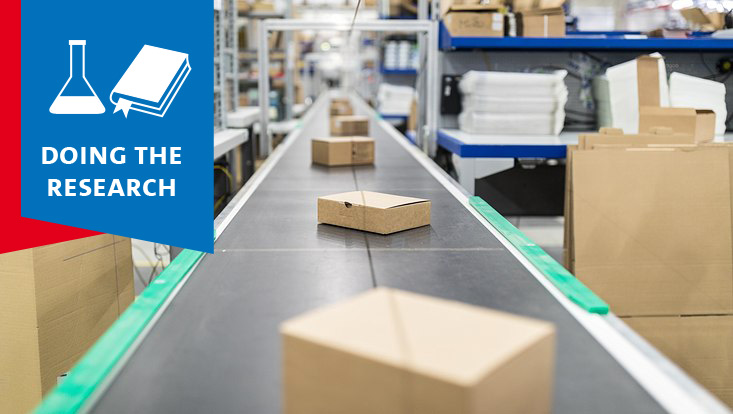Researching the relationship between productsLess cost, Less carbon dioxide: Reducing Packages in Online TradeDoing the Research series
5 December 2023, by Matthew Fennessy

Photo: iStock/alvarez
More and more is being bought online, and that is leading to ever more packages. Often, individual articles in the same order are sent separately, which is expensive and not sustainable. Dr. Tobias Vlćek and Prof. Dr. Guido Voigt from the Faculty of Business Administration are looking into how products can be stored to reduce the number of packages sent.
How does one single order become multiple packages?
Many online businesses are growing rapidly and expanding their product range. While it is easy to expand the range of products available online, in terms of logistics, it requires additional physical capacity, i.e., additional warehouses, known as fulfillment centers.
One of the consequences of this expanded capacity is what is known as decentralized dispatch. This occurs when products are stored in different centers and thus requires more packages for delivery. This increases costs while also leaving a larger ecological footprint.

Shouldn’t all products be in the same place when possible?
It’s not that easy. In theory, decentralized dispatch can be prevented by having all the products in every fulfillment center. However, separate delivery may of course be required if one of the products in an order is sold out and has to be delivered later.
Additionally, storing all products in one place is often impossible for reasons of space, and does not make economic sense. The costs of this additional storage quickly exceed the costs arising from decentralized dispatch procedures. Also sometimes multiple centers are used to deliver more quickly to a larger area.
How do you apply your research when multiple centers are needed?
We look at how decentralized dispatch procedures can be reduced by intelligent allocation of products to individual centers, using product relationships. If we take a simple example, an online business with two warehouses sells smartphones, phone covers, lamps, and lightbulbs. There is only room in each warehouse for two product categories.
If products are assigned to these warehouses without looking at the relationships between the categories, smartphones and lightbulbs could be stored in one, while phone covers and lamps would be stored in the other. It’s not hard to see that there could be a better way to organize it. Instead of building new warehouses or expanding existing ones, intelligent allocation could be much more effective.
As part of your research, how do you determine potential allocations?
Interesting relationships for a meaningful allocation exist on multiple levels, for example, between product categories, brands, or between the products themselves.
Big online sellers can quickly find themselves with hundreds of product categories, and hundreds of thousands of individual products. In such cases, it is not possible to manually organize the products well, and given how quickly some products move, often doesn’t make sense.
As part of our research we have developed an algorithm that generates improved warehouse allocations based on previous customer orders and recognized product characteristics. We have been able to test this automated allocation against a range of order data and warehouse set-ups and have shown that it is superior to previous, literature-based approaches.
So, you have already tested your research in practice?
Yes, in collaboration with a European online marketplace, we tested our new algorithm on real data, and were able to show that the number of packages can potentially be reduced by hundreds of thousands. We plan to publish our results in a journal article in 2024.
At the same time, we are also continuing to work on the algorithm and add in new functions, like using machine learning to predict future orders, as a means of preparing fulfillment centers. In the medium-term, we are interested in founding a spin-off from the University and commercial application with relevant partners. Our forecasts suggest potential financial and environmental savings of up to multiple millions of Euro and thousands of tons of CO₂, and that per business.
Doing the Research
There are approximately 6200 academics conducting research at 8 faculties at Universität Hamburg. Many students also often apply their newly acquired knowledge to research practice while still completing their studies. The Doing the Research series outlines the broad and diverse range of the research landscape, and provides a more detailed introduction of individual projects. Feel free to send any questions and suggestions to the Newsroom editorial office(newsroom"AT"uni-hamburg.de).


